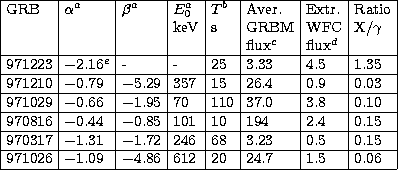
a Parameters from the phenomenological law after Band et al. (1993).
|
First, all the GRBs that are known (through a BATSE accurate localization, i.e. LOCBURST, [Kippen et al. 1997]) to have occurred within the WFC field of view have shown a detectable X-ray counterpart. Second, we have taken a small sample of GRBs detected by the GRBM and extrapolated the best-fit to the average 40-700 keV energy spectra downwards to the WFC energy range (2-20 keV). Of course, this procedure includes large uncertainties in the spectral parameter extrapolation due both to statistical errors and to the assumption that the same law holds at low energies. However, the results are reported in Table 1 and show the expected fluxes for these bursts. In all cases they are in a range of quite easy detectability with the WFC.
Even if the above considerations are in no way conclusive, they suggest that the WFC sensitivity happens to be well matched with the GRBM and BATSE sensitivity.

a Parameters from the phenomenological law after Band et al. (1993).
|
Copyright The European Southern Observatory (ESO)